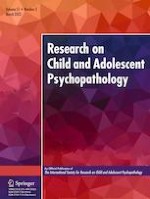24-11-2022
Attentional Biases and their Push and Pull with Rumination and Co-Rumination is Based on Depressive Symptoms: a Prospective Study of Adolescents
Gepubliceerd in: Research on Child and Adolescent Psychopathology | Uitgave 3/2023
Log in om toegang te krijgenAbstract
Emotion regulation (ER) is central to adolescent mental health and wellbeing. However, the mechanisms underlying two common ER strategies – rumination and its interpersonal counterpart, co-rumination – are insufficiently understood in youth. Past research has documented that attentional disengagement biases are associated with rumination in adults, particularly among individuals with elevated depressive symptoms. Extending this line of research, the current study investigated whether attentional disengagement biases predicted rumination and co-rumination in adolescents based on their symptoms of depression. Using a multi-wave prospective design, 91 early adolescents (47% female, Mage = 12.87) completed a measure of depressive symptoms and the Affective Posner Task to assess early and late attentional processes at baseline. Adolescents also completed measures of rumination and co-rumination at baseline and every 3-months for one year. A multivariate means-as-outcomes multilevel model indicated that early disengagement biases for sad and happy faces interacted with depressive symptoms to predict later rumination and co-rumination. Critically, the direction of findings across rumination and co-rumination differed based on depressive symptoms. Results are the first to delineate a distinct pattern of attentional disengagement biases that predict rumination versus co-rumination in early adolescents. Findings extend theoretical conceptualizations of rumination to youth and provide the first account of cognitive mechanisms underlying co-rumination.
